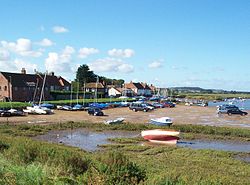Burnham Overy
| Burnham Overy | |
| Norfolk | |
|---|---|
 The Staithe | |
| Location | |
| Grid reference: | TF843435 |
| Location: | 52°57’26"N, 0°44’32"E |
| Data | |
| Population: | 311 |
| Post town: | King's Lynn |
| Postcode: | PE31 |
| Local Government | |
| Council: | King's Lynn and West Norfolk |
Burnham Overy is a village on the north coast of Norfolk. It is effectively two hamlets; known as Burnham Overy Town, which is the original village adjacent to the parish church, and Burnham Overy Staithe, a rather larger hamlet about a mile away beside harbour at the creek-mouth. Burnham Overy Town is now reduced to a handful of houses.
Burnham Overy is found between the larger village of Burnham Market, less than 1 mile to the west, and Holkham, some 3 miles to the east. Burnham Thorpe, the birthplace of Horatio Nelson, lies a mile to the south-east. According to various letters and documents, Nelson learned to row and sail a dinghy at Burnham Overy Staithe, at the age of 10, two years before joining the Navy.
The major town of north Norfolk, King's Lynn, is fully 20 miles to the southwest, and the county town, the City of Norwich is 30 miles to the southeast.


History
Historically Burnham Overy was the port for the surrounding villages of the Burnhams. Both Burnham Overy Town and Burnham Overy Staithe stand on the River Burn. Until the end of the Middle Ages trading ships were able to reach Burnham Overy Town, but with the silting of the river, commercial traffic stopped downstream and the Staithe developed.
With the coming of the railway to the Burnhams in 1866, commercial shipping declined and the last cargo is believed to have been shipped from the Staithe soon after the end of the First World War.[1]
Whenever a ship arrived, a gong would be sounded at the top of Gong Lane. This alerted the farm workers to unload the incoming goods.
Coast and marsh

Between Burnham Overy Staithe and the sea, the river spreads out into multiple tidal creeks through the salt marshes that fringe this stretch of coast, and finally reaches the sea by passing though the fronting sand dunes at a gap locally known as Burnham Harbour. Small boats can reach Burnham Overy Staithe through this gap and creek.
Today Burnham Overy Staithe, and the associated harbour, is a major recreational sailing centre. It is also the point of departure for ferries to the Scolt Head Island National Nature Reserve.
To the east of the Burnham Overy creek, the former salt marshes between dry land and the sand dunes have been reclaimed to form fresh water meadows, part of the Holkham estate. A footpath one and a half miles long links Burnham Overy Staithe to the sand-dunes and beach, running along the crest of the embankment which protects these water meadows from the creek.
Outside links
| ("Wikimedia Commons" has material about Burnham Overy) |
- Photographs of Burnham Overy Staithe
- Tide tables for Burnham Overy Staithe
- Information from NorfolkCoast.co.uk on Burnham Overy.
- Webcam showing the harbour at Burnham Overy Staithe
References
- ↑ Burnham Overy Staithe Harbour Trust
